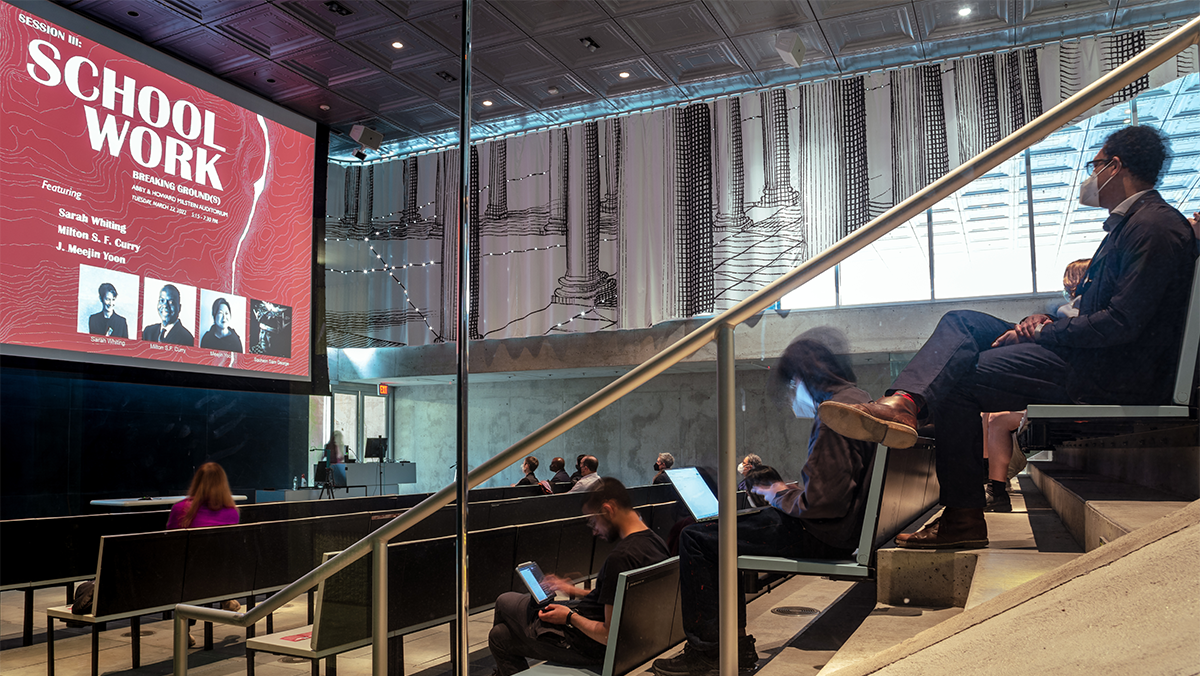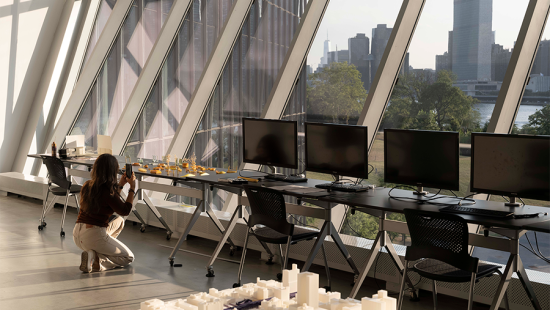SCHOOLWORK: Reimagining Pedagogy for an Evolving World
The 2022 Preston Thomas Memorial Symposium series Breaking Ground(s) concludes with "Schoolwork," three lectures and a dialogue between leading voices on architecture and design education today and in the future.

In the closing session of the Breaking Ground(s) symposium, "Schoolwork," deans University of Southern California School of Architecture Dean Milton Curry, Harvard Graduate School of Design Dean Sarah M. Whiting, and Cornell AAP Dean J. Meejin Yoon each offered sobering yet inspired presentations that envisioned possible futures for both students within the discipline and for the discipline within the world. In the panel discussion that followed, moderated by Associate Professor of Architecture Jenny Sabin and HAUD Assistant Professor María González Pendás, audience members found a rare opportunity to engage in conversation with the deans about the critical futures of architectural education and practice.
Symposium organizer Caroline O'Donnell, chair and faculty of the Cornell Department of Architecture, framed the session with opening remarks that contextualized the conversation as one that would grapple with the role of education in shaping relationality, space, and livability in the coming decades. "In our last session, we turn our attention to the academy," announced O'Donnell, prefacing the session with opening questions: "How do we prepare students for the future of architecture — a career that will last from 2022 to 2072? How can what we teach today prepare the leaders of the future to address changes, when we don't even know yet what that world will be?" O'Donnell continued, "Luckily, it's in our DNA to imagine the future, to literally envision it, to draw it, to shape it, to try it out, and to make that invisible vision visible to others. That is in our hands. So tonight's session, 'Schoolwork,' looks at the education of the architect and asks how we might reimagine architectural pedagogy for that evolving world."
Dean Curry proposed four tenets around which, he argued, design thinking should re-orient itself in order to meet the challenges of the 21st century: practicing egalitarianism, democratizing culture, recentering the subaltern, and rethinking modernity. These tenets place questions of repair, resource distribution, interdisciplinarity, and inventive creative praxis front and center — marking an ideological and pedagogical shift, as Curry noted, "from form to program." He advocated for problem-based studio learning with a focus on addressing imminent dilemmas of the built environment, rather than dwelling in speculative futures. Curry pointed to the critical significance of architectural education in the work of creating the reparative spatial and relational practices of the next generation. "Architecture, for me, always begins here, at the academy, the university...Architecture is political," Curry asserted. By extension, he warned, as institutions of higher education continue to be contested sites in ongoing culture wars, "this will put us in the crosshairs of the neoliberal university." Yet, Curry argued, architectural thinking within the academy should not seek to maintain the status quo. It should instead emphasize interdisciplinarity: "Fifty percent of our graduates are not working in traditional architectural fields...So, what are we training students for?" By aligning architectural thinking with repair and reinvention, this demands that the university become more, not less, porous; it must respond to disciplinary need, rather than remain dictated by institutional interest.
In order to be most effective outside the discipline, Dean Whiting suggested that architectural education needed to renew its investment in the foundational practices of the discipline. She advocated for design specificity and communicative practice as two core ambitions that should be at the forefront of architectural education as it trains students to address intersecting contemporary crises. She opened with the challenge: "Why has the expansion of the discipline come at the expense of considerations of form?" Given that architectural structures and systems define bounded forms that regulate inside and outside, access and exclusion, Whiting noted a pervasive disciplinary anxiety over the responsibility of creating limits, and the consequences of doing so. "One plea for the future of architecture is for the importance of specificity, and acknowledgement of specificity in what we do: we create walls, we create spaces, we use materials. And that means thinking through that specificity...it means working out the specificities of each decision we make, carrying them through an entire project, to see how a radius or particular material effects form, program, relations, and possibilities — how it affects futures."
Whiting argued that careful consideration in design must also go hand in hand with representational and communicative practices. "I firmly believe that what makes a design education so incredible is that it’s equally visual and verbal. I don't know other disciplines that have that powerful combination. It's also one of the reasons why a design education is so damn fun — we are constantly translating our ideas across media, trying out different ways of designing and of getting our designs across to different audiences." Communication enables the learning, collaboration, and action that is necessary to engage current spatial challenges and push core disciplinary practices further. "We need to ensure that we're advancing broadly: both regarding urgent global concerns, such as climate change, structural racism, and social justice, but also regarding disciplinary concerns, such as the role a wall, or many walls, play in constructing opportunities as well as creating definition."
In the culminating lecture, Dean Yoon invited audience members to ask difficult questions of themselves, their peers, their practices, and their disciplinary commitments. "The urgencies of our time, and the heightened awareness of just how inextricably intertwined our discipline is with the matters of our time, make this moment particularly fraught...What is the matter, and how do we as architects build, create, and enable what matters?... How do we take action to build a better world?" Her lecture surveyed the collective pedagogical practices of the studio, thesis, and archive across three institutions: MIT, Cornell, and UVA. In the span of her work as a student, educator, dean, and designer, Yoon has worked with these institutions in various capacities, and she highlighted the opportunities and challenges that came out of these experiences. "Purpose, action, and problem are what bind our discipline together. So how can we reimagine architecture education to prepare us for our present and our future? If we use the lenses of purpose, action, and problem, I think we can begin to understand what's resilient, recursive, or contingent in our existing pedagogical models." Through this lens, Yoon mined the lessons of institutional entanglements — looking back, in order to look forward. She optimistically offered that we can find "new futures tucked away" in such modes of institutional interrogation. Speaking to specific histories of harm embedded within the academy, she stated, "Institutions are incomplete, and we have the agency to change them." To do so, Yoon proposes that architectural expertise be coupled with an ethos of care, to continuously ask: "Who builds; for whom; with what?"
Sachem Sam George, who commenced the symposium by putting through Words Before All Else, returned to steward its conclusion by speaking closing words.
Please visit AAP's spring 2022 Preston Thomas Memorial Symposium event page for complete and up-to-date information. Go here for AAP's full Art and Architecture anniversary programming.
Stay connected! Follow @cornellaap on Instagram, Facebook, Twitter, and LinkedIn; and subscribe to our AAP bi-weekly newsletter.







